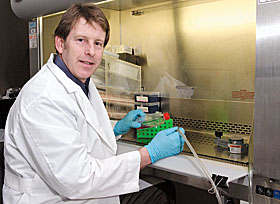  |
| HOME | THIS ISSUE | CALENDAR | GRANTS | BACK ISSUES | < BACK | NEXT > |
Stem cell researchers study reprogrammed adult cells by David Bauman - April 2, 2007 |
||||
| A newly published study by UConn researchers confirms the potential of reprogramming cells by cell fusion. The technique can create stem cells for use in research, without harming embryos. The study is likely to intensify mounting scientific interest in reprogramming ordinary adult cells – somatic cells – back to their pristine condition when they were stem cells in the embryo. The researchers, led by Theodore Rasmussen of UConn’s Center for Regenerative Biology; Rachel O’Neill of the Department of Molecular and Cell Biology; and Winfried Krueger of the UConn Health Center’s Department of Genetics and Developmental Biology, reported their findings in the online edition of Stem Cells, a highly regarded journal that focuses on stem cell research. Dominic Ambrosi, a doctoral student in molecular and cell biology, is first author on the paper. “Our results show conclusively that factors in embryonic stem cells can reprogram the somatic genome, providing a possible avenue to create pluripotent stem cells without cloning,” says Rasmussen. Stem cells are the master cells that develop into the many different types of specialized cells that make up the body. The potential of embryonic stem cells to become virtually any kind of cell in the body is known as pluripotency. Currently, the only sure way to get pluripotent stem cells is to extract them from surplus frozen embryos or from embryos created through nuclear transfer – a procedure also known as therapeutic cloning. Either way, the process is controversial, because extraction destroys the embryo; critics regard this as tantamount to abortion. But recent studies have shown that pluripotency may exist in certain cells that aren’t in embryos. ecause every cell in the body has the same genetic makeup, or DNA, the process of development starts with a cell that could become anything, but specializes to become liver, or brain, or heart, or muscle, or skin. To become specialized, cells acquire different patterns of gene expression, with some genes turned on while others remain silent. Scientists have hypothesized that if the patterns of gene expression that produce specialization could be undone, and the process were run in reverse, cells from liver, heart, brain, muscle, or skin could be returned to stem cells like those from which they began. Reprogramming seeks to switch on or off the appropriate genes to transform an adult cell back to the equivalent of an embryonic stem cell. This method could, in theory, mass produce stem cells while bypassing entirely the problems posed by the use of frozen or cloned embryos.
The research published by Rasmussen and his colleagues at the Center for Regenerative Biology and the Health Center is based on mouse cells. Following earlier experiments that demonstrated adult cells could be reprogrammed back into pluripotent stem cells, the UConn researchers blended mouse embryonic stem cells with mouse adult cells in a special chemical mixture. After 12 days, several hybrid cell colonies were identified and selected for further culture. From these, the team was able to establish four stable stem cell-like lines, which they used to study gene expression from the hybrid cells. Monitoring the hybrid cells, the UConn team discovered patterns of gene expression that made it clear the cells in the clusters were not simply the sum of the expression patterns of the parental fusion partners. Some genes were silenced, while others were activated, demonstrating that the adult cells had been reprogrammed. Rasmussen says the UConn researchers chose the mouse for their study because its genome – the entire DNA sequence of an organism – has been mapped, and that is key to understanding the structure, organization, and function of DNA in mouse chromosomes. “Now we can look at which genes are being expressed and get an idea of which genes are important for reprogramming because we know the complete DNA sequence of the mouse genome in the somatic cells,” Rasmussen says. “We can distinguish the gene expression that arises from chromosomes of somatic cell origin from gene expression arising from chromosomes of embryonic stem cell origin. “In future studies, the next step will be to try and manipulate those genes,” he adds. If scientists can understand the process, the information may ultimately provide a basis for comparative studies with human embryonic stem cells. “We may be able to produce reprogrammed human cells someday soon, based on the knowledge that we have obtained with the mouse system,” Rasmussen says. “Such an advance could lead to the production of pluripotent human cells with therapeutic value that will not be rejected by the prospective patient’s own immune system.” |
| ADVANCE HOME UCONN HOME |

